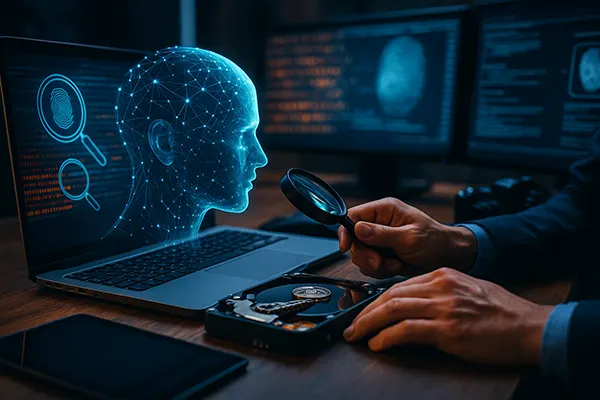
AI Forensics: How Algorithms Help Uncover Digital Crimes
Artificial intelligence has significantly transformed various domains, including law enforcement and digital investigations. As cybercrime becomes more sophisticated, so too must the tools used to combat it. AI-based forensic technologies now play a crucial role in detecting, analysing and solving digital crimes—offering law enforcement agencies an edge in a world where data is both a target and a weapon.
AI in Modern Criminal Investigations
Artificial intelligence enhances the efficiency and accuracy of digital forensic investigations. It can process vast amounts of data at speeds that far exceed human capabilities. By applying machine learning, pattern recognition and natural language processing, AI systems are able to identify suspicious activity across networks and digital devices.
One key benefit is the ability to automate routine tasks. Forensic experts can now rely on algorithms to sort through emails, chat logs, and file systems to uncover anomalies, threats or hidden files. This allows investigators to focus on interpreting results rather than being bogged down in tedious analysis.
AI also contributes to predictive modelling. It can identify potential criminal behaviour before a crime even takes place, using behavioural analysis and data from previous incidents. This is especially useful in cybercrime and online fraud prevention.
Tools and Applications in Use
Several AI tools are used in digital forensics today. For example, Magnet AXIOM employs machine learning to detect digital evidence across multiple devices, including smartphones and cloud storage. Similarly, Cellebrite’s Pathfinder leverages AI to link suspects, timelines and locations through communication data.
Natural language processing (NLP) tools help to extract meaningful information from text-heavy sources. These applications can translate and analyse multiple languages, making it easier to investigate international cybercrimes or criminal organisations that use encryption and obscure terminology.
Another example is image recognition. AI can rapidly scan through thousands of images and videos to detect illicit content, facial matches or manipulated media, which is crucial in child exploitation cases or digital blackmail investigations.
Challenges and Ethical Considerations
Despite its benefits, AI in forensics is not without challenges. False positives, data privacy, and algorithmic bias are significant concerns. An AI system may misclassify evidence or misinterpret intent, potentially compromising an investigation or legal proceeding.
Bias in AI models is especially critical. If trained on unbalanced or skewed datasets, AI can reflect and amplify societal biases—affecting how suspects are profiled or prioritised. Addressing this requires transparency in training data and continuous auditing of model performance.
There are also ethical questions around surveillance and consent. The use of facial recognition in public areas or predictive policing tools raises debates about privacy rights and the risk of overreach by authorities. Striking the balance between security and civil liberties is a continuing debate.
Legal Framework and International Standards
The use of AI in criminal justice is increasingly regulated by national laws and international agreements. For instance, the EU’s Artificial Intelligence Act introduces strict guidelines on AI systems deemed ‘high-risk’, including those used in law enforcement.
In the UK, oversight is provided through bodies such as the Information Commissioner’s Office (ICO), which monitors how biometric and personal data is used in AI investigations. Investigators must justify data collection and processing in accordance with GDPR.
Global cooperation is also expanding. Europol, INTERPOL and the UN are working towards shared protocols for AI-driven forensics. This ensures that evidence gathered using AI methods is admissible across borders and respects human rights.

Future of AI in Digital Forensics
Looking ahead, AI’s role in forensics is expected to deepen. The integration of blockchain, advanced encryption analysis, and quantum computing will shape the future of digital investigations. These technologies promise more secure evidence tracking and deeper insights into encrypted or obfuscated data.
Emerging AI models can now simulate potential crime scenarios or test hypotheses using synthetic environments. This could revolutionise crime scene reconstruction, enabling investigators to virtually ‘walk through’ events and test different narratives.
However, as technology evolves, so do criminal tactics. Dark web activity, deepfakes and decentralised apps challenge traditional forensics. AI will need to evolve rapidly to keep up with the complexity and innovation of cyber threats.
Training and Human-AI Collaboration
AI tools are only as effective as the humans who use them. Digital forensic specialists must receive proper training in using AI technologies and interpreting outputs. This ensures that they can distinguish between genuine evidence and algorithmic noise.
Human oversight remains essential. While AI accelerates investigations, critical judgement is required to contextualise results, validate findings and make legal decisions. The future lies in hybrid models, where human intuition and machine precision work hand in hand.
Investments in education, cross-disciplinary teams, and ethical guidelines will be crucial. As AI becomes standard in forensic labs, the focus must remain on accuracy, accountability and justice—not automation for its own sake.